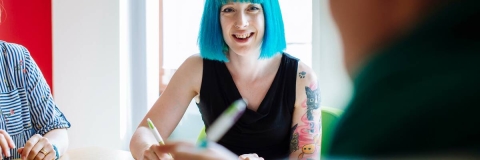
Sidebar navigation

Creative CVs
Produce an effective and dynamic CV for creative job roles
Unlike traditional CVs, creative CVs provide an opportunity to showcase your design work and demonstrate your artistic capabilities, in addition to the usual written CV content. They are typically used within industries including areas of design, art and technology, but could also be used for other areas such as marketing and media where creative content may be valued. Before applying to any roles it is first important to consider whether a ‘creative’ or ‘traditional’ CV would be most effective. Some of the questions you may ask could include: Does a creative CV complement the company/role you’re applying for? Does it reflect the best impression of you and your work? Here is our guide on creative CVs and some elements to consider.
Pros and cons of Creative CVs
- Creative CVs allow for your creativity to be actively demonstrated instead of simply stating what you can do.
- They can help you to stand out from the crowd and express your personality and individuality.
- They allow for a more ‘personal touch’ - which could be advantageous when making speculative approaches, which are common in the creative industry.
- They can act as a ‘gateway’ for an employer to view more of your work via a portfolio/showreel etc.
- The recruiters reading the CV are likely to come from a professional design background themselves and so a creative CV can help to make a strong impact, speaking to recruiters in a style that suits them.
- Some employers use Applicant Tracking Systems (ATS) to scan CVs for suitability, which may be tricky for a creative CV depending on format and file type.
- It could be a case of ‘style over substance’ - your CV still needs to have all the essential information of a ‘traditional’ CV, in a clear and readable format.
- They can be time consuming to create - would your time be better spent on creating an impactful portfolio/showreel that you could instead link in your CV?
- It could be a risky approach if your design style does not fit the ‘brand’ of the employer.
Content
The written content of a CV should be the main focus and it should not be overshadowed by images and graphics, any visual elements need to complement the content, not dominate. The images in a CV need to spark the interest of an employer and act as a gateway for them to view your portfolio. The content of a creative CV is very similar to a traditional CV (please see our CV guide.) Like traditional CVs, creative CVs need to be tailored to the job or industry you are applying to. Use your knowledge and experience of that industry, as well as the job description as a guide to determine what you will prioritise.
It is important with creative CVs to include a link to your work, either a portfolio, a website or a professional social media page. This could be included in the contact details section. Ensure that your technical/design skills are highlighted and evidenced in a creative CV, the employer wants to know what skills you have and where you have used them. You can highlight and evidence your technical skills in any work you have done, whether that is in personal projects, university work, paid or voluntary work. This is where images can be useful to complement the text, you can label them to include what software/skills were used to create them.
Layout and Design
Once you have determined the content you wish to include in your CV, the next step is to create your layout and design. This is a fantastic opportunity to showcase your design skills and your CV could be the first opportunity to demonstrate this, so think about what the employer would want to see. A carefully designed font and a touch of colour could be a good starting point and you could include elements of your work on your CV to support your portfolio. Maintaining a subtle balance between creativity and professionalism for your CV will be key; it should reflect your personal brand and style. Remember that CVs are designed to be read quickly as they provide a brief overview of your skills and experience, so ensure the reader can easily find the information they’re looking for. You may find it helpful to take a look through our Alternative CV Guide for ideas for types of format for creative CVs.
Below is a list of useful links to help you create your CV according to the industry you are applying for:
Animation
Architecture and interior design
- RIBA CV advice
- Architecture and Design Graduates – How to Secure Your First Position – Part 1 - Writing Your CV, Writing a Cover Letter
- CV toolkit for Architecture students - First in Architecture
- Architecture CV and Covering Letters - LinkedIn
Art and illustration
- Artsquest - promotion and application tools
- Writing an artist statement? First ask yourself these four questions - The Guardian
- Promote yourself - Artquest's guide to self-promotion
Computer Games
- Grads in Games
- datascope - CV advice for programmers, artist and animators, games/level designers
Drama and performing arts
- Acting CV 101: Beginner Acting Resume Example for Inexperienced - Acting in London
- How to create an acting CV in the UK - Backstage
Graphic and web design
- Graphic designers share their top tips for a standout CV - The Stylist
- How to create the perfect design resumé - Creative Bloq
Photography
Film, TV & radio CV
- How to write a CV for the film and TV industry
- CV advice - My first job in film
Media and journalism
Here are some further examples of creative CVs:
- Computer Games Technology 1
- Computer Games Technology 2
- Creative and media writing
- Creative media technologies
- English and creative writing
- Fashion
- Fashion and textiles 1
- Fashion and textiles 2
- Film Production 1
- Film Production 2
- Graphic Design 1
- Graphic Design 2
- Illustration 1
- Illustration 2
- Interior architecture and design
- Photography 1
- Photography 2
- Television and broadcasting
- Television and film
Resources/Additional links
- 17 Awesome Examples of Creative CVs - Guru
- A complete guide to creating a creative CV - Journal article medium.com
- Creative CV Guide - University of the Arts London (UAL)
- Creative CVs - Prospects
- How to Write a Creative CV - Indeed

